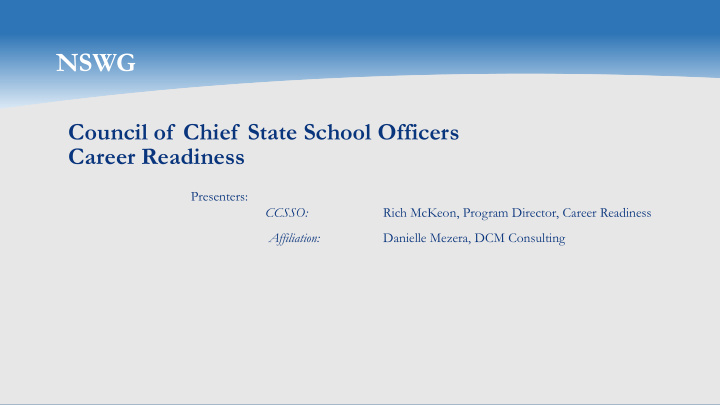



NSWG Council of Chief State School Officers Career Readiness Presenters: CCSSO: Rich McKeon, Program Director, Career Readiness Affiliation: Danielle Mezera, DCM Consulting
Postsecondary Attainment Rates
CCSSO Task Force on Career Readiness 1. Enlist the employer community as a lead partner in defining the pathways and skills most essential to today’s economy; 2. Set a higher bar for the quality of career preparation programs , enabling all students to earn a meaningful postsecondary degree or credential; and 3. Make career readiness matter to schools and students by prioritizing it in accountability systems.
New Skills for Youth • JPMorgan Chase funded initiative in 2015 • Phase 1: • 44 states applied for 25 grants: $100,000 Grant • Established in-state, cross-sector teams • Coaching Support • Deliverables: Needs Analysis, 3 year action plan, Evidence of Progress • Opportunity to apply for Phase 2 Funding decided by External Review Committee • Phase 2: • 24 states competed for 10 grants; $2,000,000 over 3 years • Ongoing Coaching Support • Regular Convenings with state cross-sector teams • Webinars, Affinity Groups
Cross Sector Teams
Key Objectives Demand Driven and Employer Rigor and Quality in Career Career-Focused Accountability Led Processes Pathways for ALL Systems Establish employer-driven processes Use policy and funding levers to Incorporate robust career-focused informed by real-time and other labor improve the quality and rigor of indicators in state accountability market data to determine high-skill, career pathways – including phasing systems that measure and value high-demand industry sectors with out those that don’t lead to successful completion of meaningful which career pathways and programs credentials of value – and make those pathways, work-based learning, must be aligned. pathways widely available to and enrollment in postsecondary accessed by all students in all education or apprenticeships, and secondary settings, especially in credentials of value. underserved populations
Key Objectives Cont. Scaled Pathways that Align State and Federal Ensure Cross-Institutional Culminate in Credentials Funding Streams Alignment Working with local districts, scale Reorganize and intentionally align Foster greater collaboration between career pathways that span secondary state and federal funding streams K-12 and postsecondary institutions and postsecondary systems, offer from education, workforce to adopt policies and processes in focused career guidance and development, and economic schools, technology centers, advisement, blend rigorous core development sources to effectively academies, and institutions of higher academic and career-technical delivery career-focused programs to education to ensure cross- instruction, include high-quality WBL all students. institutional alignment of programs experiences, and culminate in and pathways that smooth transitions postsecondary or industry credentials for students and minimize of value institutional barriers.
Career Readiness Network States
Ways to Engage • Opportunities and Options Monthly Newsletter • Learning that Works Resource Center • Career Readiness Network Webinar Series • Contact CCSSO’s CR team • Partner Convenings
Current Landscape: Perkins and Required Indicators 2006 Carl Perkins IV Act • Prescriptive data indicators ( core indicators of performance ) • Several definitions outdated, making usefulness limiting • Several misaligned with (1) state data reporting and (2) reauthorized federal acts • Several data are self-reported (teacher/student) • Leads to suspect data, which leads to suspect reported information • Proposed reauthorization bill (HB: “Strengthening Career and Technical Education for the 21st Century Act”) attempts to address concerns on data collection and information reporting
State Longitudinal Data Systems: Data Collection and CTE Reporting SLDS Interagency data system that provides a view of student trajectories from childhood to the workforce • Matching algorithms link records from different data sets to give long-term views of student cohort’s path • Lagging data • Data set generally includes: • K-12 data • Postsecondary data • Transition • Completion/attainment (program and degree type) • Financial aid • PLA • Employment by industry CTE • Must fully integrate CTE data with SEA’s/SAHE’s information systems • Guiding questions must be established to inform CTE data collection at K-12/higher education levels • CTE reportable data must flow into SLDS – CTE data represented in SLDS policy and framework • Reciprocal data flow: SLDS data must flow back to CTE to better inform strategic planning, accountability, and evaluation
“Career Readiness”: Changing the State Reporting Landscape • Change from “Apples to Oranges” to “Apples to Apples” CTE data reporting • Move away from CTE Self Reported data to Objectively Reported data • Pursue comprehensive SEA/SAHE data strategies designed to affirm state progress in ensuring students are successful in their education-to-career learning pathways • Data analyses training for CTE-related end users to drive planning integrated with broader LEA strategic plan and state plan • K-12 Data Pillars (not exhaustive) • Course codes (CTE, early postsecondary, WBL, learning support/remedial, etc.) • College entrance exams and benchmarks (ACT/SAT) • Industry certifications (directly from vendor/exam provider) • Student achievement (end-of-course assessment) scores • Student predictive • GPA • Student attendance • Student profiles (race/ethnicity, gender, socio-economic, IEP, etc.) • Cohort graduation (not CTE concentrator graduation)
Recommend
More recommend